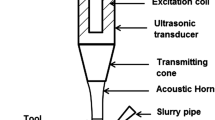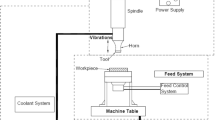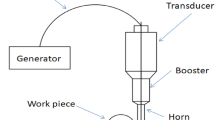Abstract
Rotary ultrasonic machine (RUSM) has a lot of applications in industries, with the recent uses of stronger and harder materials. Machining performance of RUSM depends on the design of the horn. A horn also known as a tool holder or concentrator is a waveguide focusing device, which has a decreasing area of the cross section from the upper to lower end. In RUSM, the high amplification factor of the horn is required to increase tooltip vibration for getting a high material removal rate. In this study, the design of the horn using an optimization procedure and finite element analysis (FEA) has been done. FEA-based MATLAB code has been developed for finding all the stress components, axial amplitude, and resonance frequency. Results are validated from the experimental data available in the literature, and it has been found that it is in good agreement with the literature. The amplifications of the horns with cubic and quadratic profiles 23.8% and 19%, respectively, are higher than the traditional horn with the same length and diameters of the ends. Stresses at different locations have been found within the allowable endurance limit. The effect of frequency on the stress distribution has also been studied and found that the variation of stresses over the domain of horn increases with an increase in frequency, but the value of stress is much lower at the resonance frequency.




























Similar content being viewed by others
References
Rozenberg LD, Kazantsev VF, Makarov LO, Yakhimovich DF (1964) Ultrasonic cutting. Consultants Bureau, New York
Ghosh A, Mallik AK (2002) Theory of mechanisms and machines. Manufacturing Science EWP Pvt. Ltd., New Delhi
Kremer D, Saleh SMS, Ghabrial R, Moisan A (1981) The state of the art of ultrasonic machining. CIRP Ann Manuf Technol 30(1):107–110
Ray A, Jagadish (2018) Design and performance analysis of ultrasonic horn with a longitudinally changing rectangular cross section for USM using finite element analysis. J Braz Soc Mech Sci Eng 40(7):359. https://doi.org/10.1007/s40430-018-1281-7
Kumar V, Singh H (2018) Machining optimization in rotary ultrasonic drilling of BK-7 through response surface methodology using desirability approach. J Braz Soc Mech Sci Eng 40(2):83. https://doi.org/10.1007/s40430-017-0953-z
Anand K, Elangovan S (2019) Modelling and multi-objective optimization of ultrasonic inserting parameters through fuzzy logic and genetic algorithm. J Braz Soc Mech Sci Eng 41(4):188. https://doi.org/10.1007/s40430-019-1685-z
Jain VK (2002) Advanced machining processes. Allied, New Delhi
Seah KHW, Wong YS, Lee LC (1993) Design of tool holders for ultrasonic machining using FEM. J Mater Process Technol 37(1–4):801–816
Amin SG, Ahmed MHM, Youssef HA (1995) Computer-aided design of acoustic horns for ultrasonic machining using finite-element analysis. J Mater Process Technol 55(3–4):254–260
Thoe TB, Aspinwall DK, Wise MLH (1998) Review on ultrasonic machining. Int J Mach Tools Manuf 38(4):239–255
Ya G, Qin HW, Yang SC, Xu YW (2002) Analysis of the rotary ultrasonic machining mechanism. J Mater Process Technol 129(1–3):182–185
Yadava V, Deoghare A (2008) Design of horn for rotary ultrasonic machining using the finite element method. Int J Adv Manuf Technol 39(1–2):9–20
Wang DA, Chuang WY, Hsu K, Pham HT (2011) Design of a Bézier-profile horn for high displacement amplification. Ultrasonics 51(2):148–156
Ioan-Calin R, Mihail-Ioan P, Nicolae C (2015) Experimental and numerical study on an ultrasonic horn with shape designed with an optimization algorithm. Appl Acoust 95:60–69
Roy S, Jagadish (2017) Design of a circular hollow ultrasonic horn for USM using finite element analysis. Int J Adv Manuf Technol 93:319. https://doi.org/10.1007/s00170-016-8985-6
Naseri R, Koohkan K, Ebrahimi M, Djavanroodi F, Ahmadian H (2017) Horn design for ultrasonic vibration-aided equal channel angular pressing. Int J Adv Manuf Technol 90(5–8):1727–1734
Kumar S, Ding W, Sun Z, Wu CS (2018) Analysis of the dynamic performance of a complex ultrasonic horn for application in friction stir welding. Int J Adv Manuf Technol 97(1–4):1269–1284
Razavi H, Keymanesh M, Golpayegani IF (2019) Analysis of free and forced vibrations of ultrasonic vibrating tools, case study: ultrasonic assisted surface rolling process. Int J Adv Manuf Technol 1:13. https://doi.org/10.1007/s00170-019-03718-x
Wang J, Sun Q, Teng J, Jin P, Zhang T, Feng J (2018) Enhanced arc-acoustic interaction by stepped-plate radiator in ultrasonic wave-assisted GTAW. J Mater Process Technol 262:19–31
Zeid I (1998) CAD/CAM theory and practice. Tata McGraw-Hill, New Delhi
Deb K, Pratap A, Agarwal S, Meyarrivan T (2002) A fast and elitist multiobjective genetic algorithm: NSGA-II. IEEE Trans Evol Comput 6:182–197
Goldberg DE (1989) Genetic algorithms is search, optimization & machine learning. Addison Wesley Publishing Company Inc, Boston
Timoshenko SP, Weaver W, Young DH (1990) Vibration problems in engineering. Wiley, Singapore
Timoshenko SP, Goodier JN (1970) Theory of elasticity, international edition. McGraw-Hill, New York
Satyanarayana A, Reddy BK (1984) Design of velocity transformers for ultrasonic machining. Electr India 24(14):11–20
Rao SS (2001) The finite element methods in engineering. Butterworth-Heinmann, New Delhi
Reddy JN (2005) An introduction to finite element method. Tata McGraw-Hill, New Delhi
Kwon YW, Bang H (2000) The finite element method using MATLAB. CRC Press, USA
Author information
Authors and Affiliations
Corresponding author
Additional information
Technical Editor: Paulo de Tarso Rocha de Mendonça, Ph.D.
Publisher's Note
Springer Nature remains neutral with regard to jurisdictional claims in published maps and institutional affiliations.
Rights and permissions
About this article
Cite this article
Rai, P.K., Yadava, V. & Patel, R.K. Design of Bezier profile horns by using optimization for high amplification. J Braz. Soc. Mech. Sci. Eng. 42, 309 (2020). https://doi.org/10.1007/s40430-020-02379-2
Received:
Accepted:
Published:
DOI: https://doi.org/10.1007/s40430-020-02379-2




